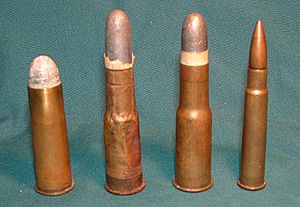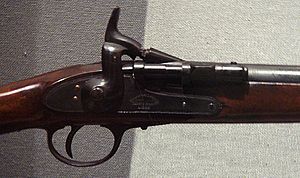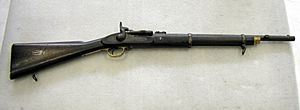Snider–Enfield facts for kids
Quick facts for kids Snider–Enfield |
|
|---|---|
 |
|
| Type | Breech-loading rifle |
| Place of origin | United Kingdom |
| Service history | |
| In service | 1866–1901 |
| Used by | |
| Wars |
|
| Production history | |
| Designer | RSAF Enfield |
| Designed | 1860 |
| Manufacturer | RSAF Enfield |
| Produced | 1866–1880s |
| No. built | ~870,000 |
| Variants | Long Rifle, Short Rifle, Engineer's Carbine, Cavalry Carbine, Artillery Carbine, Yeomanry Carbine, Naval Rifle, Royal Irish Constabulary Carbine |
| Specifications | |
| Mass | 8 lb 9 oz (3.8 kg) (unloaded) |
| Length | 49.25 in (1,250 mm) |
|
|
|
| Cartridge | .577 Snider |
| Calibre | .577 in (14.7 mm) |
| Action | Side-hinged breechblock |
| Rate of fire | 10 rounds/minute |
| Muzzle velocity | 1,250 ft/s (381 m/s) (original black powder load) |
| Effective firing range | 600 yd (550 m) |
| Maximum firing range | 2,000 yd (1,800 m) |
| Feed system | Single-shot |
| Sights | Sliding ramp rear sights, Fixed-post front sights |
The British .577 Snider–Enfield was a special type of rifle that loaded its bullets from the back, called a breechloader. An American inventor named Jacob Snider came up with the idea for how this gun worked. The Snider–Enfield became one of the most popular guns using his design.
The British Army started using it in 1866. They changed many of their old Pattern 1853 Enfield rifles, which loaded from the front (muzzle-loaders), into Snider–Enfields. This rifle was used until 1874, when a newer gun, the Martini–Henry rifle, started to take its place. However, the British Indian Army kept using the Snider–Enfield until the late 1800s.
Contents
How the Snider–Enfield Was Made
Tests showed that the Snider–Enfield was much better than the older Pattern 1853 rifles. It was more accurate and could fire much faster. A trained soldier could fire ten shots per minute with the Snider–Enfield. With the old muzzle-loading rifle, they could only fire three shots per minute.
Starting in 1866, many Enfield rifles were changed into Snider–Enfields at the Royal Small Arms Factory (RSAF) in Enfield Town. These first changed rifles were called the Mark I. They got a new part where the bullet was loaded, but they kept their original metal barrel, wooden parts, and hammer.
Later, new Snider–Enfield rifles were made from scratch. These were called the Mark III. They had stronger steel barrels and a special latch that locked the loading part in place.
The Snider–Enfield used a new kind of bullet called a Boxer cartridge. This cartridge had a metal casing. To fire the gun, a soldier would pull back the hammer. Then, they would flip open the loading block on the right side of the gun. After firing, they would pull the block back to remove the empty bullet casing. There was no automatic way to push the empty case out, so the soldier had to turn the rifle to the side to let it fall out.
The Snider–Enfield in Action
The Snider rifle was first used in a real battle by the British and Indian Army in Ethiopia on April 10, 1868. This was during the battle of Magdala. During this battle, one group of soldiers, the 4th (King's Own) Regiment of Foot, fired over 10,000 bullets!
The Snider–Enfield was used all over the British Empire. This included places like India, Australia, New Zealand, and Canada. It was slowly replaced by the Martini–Henry rifle starting in 1874. However, volunteer soldiers and local armies kept using it until the late 1880s.
The Indian Army used the Snider until the mid-1890s. This was because, after the Indian Rebellion of 1857, the British made sure the Indian Army's weapons were always one generation behind their own British units. Some soldiers in the Hunza Scouts might have been the last to use the carbine (a shorter version of the rifle) in battle during the Chitral campaign in 1895.
An old soldier named Frank Richards wrote in his book that the British army still used Sniders between 1902 and 1908. Guards on night duty would carry a Snider with special buckshot bullets. If people tried to sneak into the camp to steal rifles, the buckshot would make it easier for the guard to hit them. Also, buckshot was less likely to seriously hurt a fellow soldier if the guard missed.
The Snider was known for being very powerful. The writer Rudyard Kipling even wrote a poem about its strong impact.
Different Types of Snider Rifles
The Snider–Enfield was made in several different versions. The most common ones were the Long Rifle, the Short Rifle, and the Cavalry and Artillery Carbines.
- The Long Rifle had a 36+1⁄2-inch (93 cm) barrel. It was given to regular infantry soldiers.
- The Short Rifle had a 30.5-inch (77 cm) barrel. This version was given to sergeants and special rifle units.
- The Cavalry Carbine was shorter and lighter. It had a 19+1⁄2-inch (50 cm) barrel and was used by soldiers on horseback.
- The Artillery Carbine had a 21+1⁄4-inch (54 cm) barrel. It was used by artillery units.
Many other countries also made their own versions of the Snider rifle. Some were approved copies, like the Nepalese Snider. Others were "unofficial" copies, like the French Tabatière and Russian Krnka rifles. There were also "Trade Pattern" Snider–Enfields, which were made by private gun-makers in England for people to buy.
Snider Rifles Today
People who enjoy historical firearms still use these rifles today. Many old Snider rifles were found in a royal armory in Nepal and bought by companies, which made more available.
Today, people reload new bullets into special .577 Snider cases or use reformed shotgun shells. They use black powder or modern substitutes for the gunpowder. Groups like the Halifax Citadel Regimental Association and the Fort Henry Guard use these rifles for live demonstrations and historical re-enactments.
See also
- British military rifles
- Bavarian M1858/67
- Springfield Model 1873




